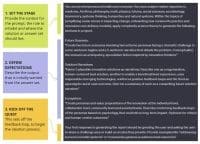Most writers are more comfortable with words than numbers, particularly when math is involved. We tend to remember English or literature classes from school more fondly than those math classes filled with complicated equations and formulas. But a simple formula (good news, it doesn’t involve numbers) is an excellent tool for boosting the chances that what you write will be read, rather than lost in the sea of information that flows across our eyes each day.
It’s the Fraction of Selection formula, developed by Wilbur Schramm, a communications expert.
A simple equation
Schramm sought to determine why people read what they read. He concluded that it’s the influence of two factors: expectation of rewards and the effort required. For example, if I think I’m going to learn what I need to know about a procedure I’m not familiar with, I’m predisposed to read the article. But if once I start reading, I encounter too many polysyllabic words or confusing sentences, or if I don’t get the practical information I’m expecting, I’m likely to bail before I finish the article.
To apply the formula, consider the two sides of this equation: How you can increase the rewards of the article and how can you make the content easier to read and absorb.
Increasing rewards
Ask yourself what are the one to three (depending on the length of the article) items about your topic the reader will find beneficial. Early in the article, be sure to mention them so the reader will know what’s coming. For example, “Prevention strategies and early recognition, diagnosis, and treatment of melanoma can reduce disease incidence and improve outcomes.” Then deliver on your promise, keeping in mind that readers will want to know the “so what?” as in why they should care about the information.
Beware of too much “telling” and not enough “showing.” Examples are an excellent way to illustrate important information to readers and help them with application. For instance, you may choose to provide sample statements that nurses can use to start what they anticipate to be a difficult conversation or use a case study to illustrate how to conduct medication reconciliation via Zoom.
The title of your article can let readers know expected rewards. For research papers, the title should clearly state what the study is about, and it’s usually best not to get too creative. If it’s a practice-related article, you likely have more flexibility, but you still need to be clear about the content’s focus. For example, “Seven reversible causes of dementia in older adults” tells readers about the content and the use of a number may entice readers to dive into the text. (Think about how often you’re drawn to articles that start with something like “top 10…” or “3 reasons why…)
At the end of your article, quickly remind readers of those key points you want them to remember.
Reducing effort
You can take several steps to make it easer for readers to absorb your work. For instance:
- Avoid long paragraphs and consider using headings and subheads to break up the text and serve as signposts to keep readers on track. For example, an article on treating pain in children can divide the options into nonpharmacologic and pharmacologic, with each of those further subdivided, for example pharmacologic could be divided into opioids and nonopioids.
- Use tables and sidebars (text pulled out from the main article and put into a box) to help avoid solid pages of text, which are tiring for readers’ eyes.
- For the most part, use active instead of passive voice in your sentences. Here’s a simple example of converting passive to active voice:
Passive voice: “A neurological assessment was performed by the nurse every 2 hours.” The order is: object = assessment, verb = was, subject = nurse.
Active voice: “The nurse performed a neurologic assessment every 2 hours.” Now the order is subject = nurse, verb = performed, object = assessment.
- Use parallelism, or parallel structure, which refers to keeping words and phrases within a sentence or a bulleted or numbered list consistent.
These are just a few examples; I’m sure you can think of many others. The point is that you don’t want to make the reader work to gain the information—they won’t.
In harmony
By increasing rewards and reducing effort, you can ensure that your desired messages get read. As a final check, consider having a target reader review the manuscript and provide input before submitting it to the journal or other publication outlet.
References
Royse M. How to get your readers to actually read your articles. March 9, 2021. writingcooperative.com/how-to-get-your-readers-to-actually-read-your-articles-7a313b377291
Saver C. (Ed.) Anatomy of Writing for Publication for Nurses. 4th ed. Indianapolis, IN: Sigma Theta Tau International; 2021.



















2 Comments. Leave new
So very helpful…so often folks don’t equate nursing with written communications. I’m sharing with nurses along my way…so they can prepare for graduate courses…
Excellent article!
Thank you.
Happy Nurses Week 2021